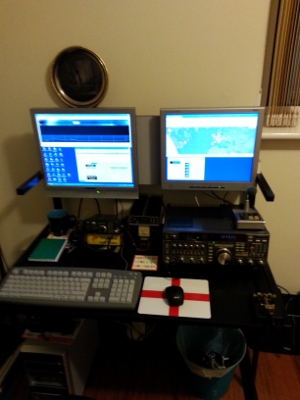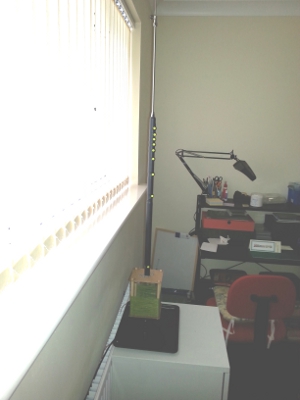Area dedicated to Amateur
radio, under my UK class A callsign G0HYN.
The
aim of this site is to provide a little information about myself, my
HAM related activities, and provide a reference point for any projects
and reference materials other operators (licensed or swl) might find
useful.
Equipment:
Having
been off the air for over 20 years and having retired early, I have
recently established a small station at our new home in Peterborough,
UK.
This station is dedicated to digital modes, which have always
interested me since I dabbled in the early days of packet radio.
 |
 |
So the
main station consists of:
Yaesu FT-767gx transceiver which I bought when I passed my morse back
in the 80s and has the 2m and 6m modules fitted.
As
I wanted to work the hf bands and didn't want to erect a large aerial
outdoors, I went for the mobile vertical multi band Intruder III from
Moonraker. This uses a jumper and adjustable top whip to tune, so I
like it near the rig to facilitate easy band change.
Currently
using an old floor standing PC and Fldigi, with a purpose bought
interface
which connects to the USB and mic/headphone sockets of the PC.
On
the rig side, just 2 connections, one to the PTT phono, and the other
to the data in/out (both on the rear of the transceiver).
Activity
2013-2014:
Although
I am still playing with the antenna location, I have been most
impressed with the performance of the Intruder on all bands from 80m to
6m, working European stations on 10 watts easily, and even work across
the pond both to the US and Canada. Now this might be purely my newness
to the digital modes such as Psk31 etc. but impressed I am...
Now looking forward to working more countries on each band, and seeing
how far I can get out.
Activity
2014:
Whilst
trying to relearn morse code, I came across a PC Windows based learning
program by ZL1AN (Gary from NZ). I so impressed with the method, that I
contacted the author to see if there was a Android version available so
that I could carry the app around on my phone to use as and when...
Unfortunately,
Gary informed me that there was no Android version, but was more than
happy to provide the project files (including the Delphi source code),
so that I might create the Android equivalent.
I've been working on
this project ever since, and despite having to battle with Android to
get things progressed, have got to a beta version which does mimic the
PC offering at least in the method of teaching morse.
Still so work to be done, but hoping to release the first usable
version soon...
Fitted
two flat screen onto what was the top shelf of my office
desk, by
simply swiveling the shelf on its rear mounting screw, drilling through
the shelf to match the screens Vesa mounting holes, and fixing a block
to the side of the shelf to stop it rotating forward (where the weight
of the screens wants to take it). See new station photo, you can just
make out the block on the right hand side.
Having
discovered that QSL.net supports Javascript, I started having a play
with it (clock in header of this page is Javascript). This made me
think; could I create a simple web based 'Learn Morse' page, so that it
would be more or less device/OS independent? Well I'm working on it,
and if you want to see how far I've got then click on the rotating
globe top right of this page... Please be aware that it's still very
much under construction, so it may not work on your browser, or work
and then not work because I'm still making changes.... but that said
it's not far off being usable now.
Having
used web SDR resources to try and track down slow morse QSO for
practice receiving, I decided I wanted one to act as a monitor for my
station transmissions in Digi-modes, but also to get a quick view of a
bands activity.
I've gone to the KN0CK upconverting HF SDR
dongle, and I eagerly await it's arrival from the US (hopefully before
Xmas :o).
Activity
2015:
So far, 2015 has been centered around the creation
of the Android morse decoding app, which has been quite a challenge,
but very rewarding. And with the help of Ron, Gary, and Nigel, we now
have a working app that has been in Alpha testing for some time.
Hopefully it will be ready for Beta testing very soon (i.e. available
to all to download and have a go at it). Please see the dedicated page
I've created for more details of it's capabilities and screen shots...
Activity
2016:
Revisited the morse reader App, with a view to improving graph update rate, and although I'd achieved a rate four times faster, testing on my Samsung Galaxy Ace unfortunately gave audio degregation, so I backed out the changes.
That said, I have uploaded Beta 1.2 as I'd also added a 'Share'
function to the playback options. This appears as an extra option
('Share externally') when a recorded file is selected, and if chosen,
will pass the file over to any Android App that advertises it can hand
.wav files.
I use it as a fast way to store the recorded files 'in the cloud' for
access from any other internet connected devices (such as my
development laptop). So basically I press 'Share externally', Android
shows me a list of Apps, and I pick the one I want to use. This is
usually DropBox, or Google Drive, but it can be a mail service such as
gMail, in which case the .wav file becomes and attachment, and the
email title the file name.
More changes to the reader app:
Beta 1.5:
Input sensitivity changed so that the app hopefully requires less volume from the source audio
Touch actions applied
to the decode, filter, and stats text fields to change font size/clear
text, and invoke filter settings or help screens
Beta 1.6 - 22-Oct-2016:
Change background colour to customborder.xml so that playback field can
be found easier for touch action
Change radius of corners in customborder.xml from 20 to 10
Added font cycling to help activity
Added lowercase/uppercase flip to main menu. Note only a...z flips to
A...Z (and back again)
Beta 1.7: 28-Oct-2016
Added AGC whichs adjust the main gain to achieve a target level, within a
tolerance range
Made
'standard' screen layout changes to get more text lines on Samsung
Galaxy Ace
Added AGC settings for Level, Speed, and Tolerance (including AGC
On/Off and reset to defaults)
Added invoke of AGC settings via single click in image field
Added AGC settings help text
Beta 1.8: 06-Nov-2016
Added playback file time remaining (elapsed obviously still used for
record)
Added 'All' settings screen to encompass Filter, AGC, and general
settings
Added save/restore of all adjustable parameters (on app stop &
start)
Added 'hide' of gain slider when AGC is active, plus recovery to manual
when AGC is switched off
News: Free Android Learn Morse app ready for you enjoyment... Download
here.
More news: Free Android Morse reading app Beta 1.8 uplaoded for testing Download
here.
NEWS FLASH (17-Nov-2016):
Both Apps now available from via Google Play store (still free of course, with no Ads or in app purchases).
Search for 'learn morse' or 'morse code reader', and look for G0HYN-Morse logo.
|


